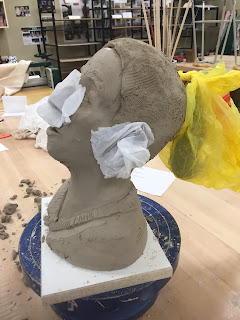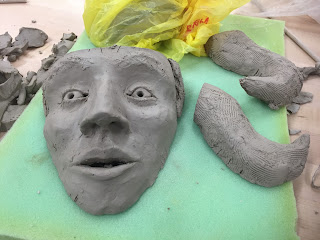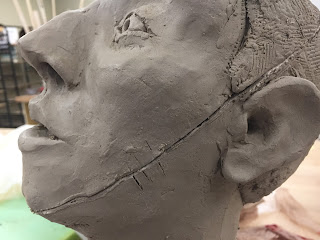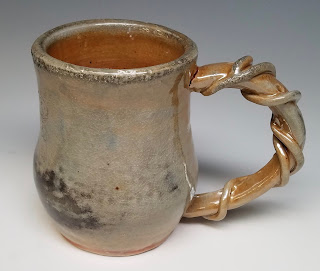This has been an incredible busy week! The quarter ended last week and grades were due Friday, but I decided to take on a fairly massive project over the break. This quarter I "flipped" my Functional Pottery class and next quarter I plan to flip my Clay 1: Hand-building class.
Flipping a class, if you aren't familiar with the term, means that students spend class time doing and homework time watching or preparing. My Functional Pottery students who chose the "flipped class format" for homework this fall watched throwing demos online in lieu of watching me demonstrate the same techniques during class. A few students students chose to watch both my online videos and the live demos.
I'm sure sometimes students skipped the videos, but this was a particularly strong quarter for Functional Pottery and the students produced particularly strong work. One of the ways I knew that students had watched the videos was that I could see them doing the techniques demonstrated in the assigned videos. Because I didn't have to demonstrate everything live during class, I was able, instead, to watch students throw and help them, individually, to improve their techniques at the wheel.
Even if I demonstrated for some students at the beginning of class, immediately after I finished, I could go see the progress of the students who flipped the class and were working during my live demo. I had very little trouble with students coming to class unprepared and I felt that we got more done during class time than in a typical class before flipping.
Before fall, I had been preparing to flip this class for some time. A few years ago I recorded video demonstrations for a whole range of throwing techniques. I spend a couple of days during summer break, all day for two days, recording the demos and then I spent some more time uploading and processing the videos. I labelled
this blog post about my videos "tedium" because I was such a fan of the process. The process of getting the videos made was annoying, mostly because I had to clean my hands between every video to operate the camera controls, but also because I spent two solid days alone, talking to the camera, but feeling a bit foolish about it.
The video project from 2016 was also annoying because I had recorded most of the videos before. I was trying to make the videos look better, rather than creating something entirely new. I can easily see the difference between the videos from 2016 and the ones recorded in 2012, but the older videos weren't totally worthless.
I used the videos from 2016 and the ones from 2012 as supplements to my Functional Pottery classes, but this fall was the first time I officially offered students the opportunity to watch me on video and not watch the live classroom demos. Getting the flipped class set up took a bit more work. I had to collect the videos into playlists and make them obvious and accessible each week through Canvas. I also had to be sure that students understood what to watch each week.

One significant advantage of the flipped format is that I was able to supplement my videos with ones done by other potters. Instead of watching my quick demonstration of a variety of surface decorating techniques, for example, students were directed to watch other artists decorate their work using a wide range of techniques and taking more time than I have during class. Students could watch the entire technique or could speed up the video to watch just the parts that pertained to their work. Students could also return to any of the demonstration videos as needed throughout the quarter. Of course students could also watch other related videos that popped up on YouTube after the assigned videos.

After such a successful quarter this fall, I was excited to flip my other classes, but I was apprehensive about the amount of tedium and effort recording all my hand-building demonstrations would take. What I really wanted was some videography help. Sometimes, if you ask for help, you'll find that it is available.
So this past week, I demonstrated while a colleague, Kevin Hager, who works with our online classes, recorded the demonstrations for me. I had a list of about 50-70 things I wanted to record and I figured, based on how long it took last year, that we would need two solid days to record everything I wanted to do. To my surprise and delight, the process took much much less time than I anticipated. We were able to consolidate the videos down to about 50 by combining some things, but we also cranked through them in about half the time I anticipated it might take, in part because he could set up the camera while I set up the clay and tools.

We spent just the morning doing videos the first two days and had to return for about an hour on the third day because one piece needed to dry and be worked on before the final video could be recorded. In all, though, the process was significantly more pleasant than in 2016. It was still exhausting, but there wasn't the associated tedium and frustration with technology (specifically, with having to clean my hands before handling technology). I was also able to rely on a second opinion for how to compose the shots. My face probably shows up more frequently in the videos Kevin recorded, but I didn't have to make the decisions about where to focus.

The videos I did this week should be processed and online in a couple of weeks (folks are off for the holidays and I am getting some help getting the videos ready). I will need to spend some time before January 2 collecting the videos into playlists for class, but the goal is to allow me to have the students spend all their classroom hours working and some of their homework hours watching the demos they would otherwise watch during class time. I'm fairly excited about the possibilities for winter quarter, which is exactly where one wants to be, mentally, in December.
The student artwork featured in this blog post was all made in my Fall 2017 Functional Pottery class. In addition to the flipped class format, this quarter I also implemented a requirement for students to take pictures of their work after each project. They took these pictures using our
new studio photo setup.

















































